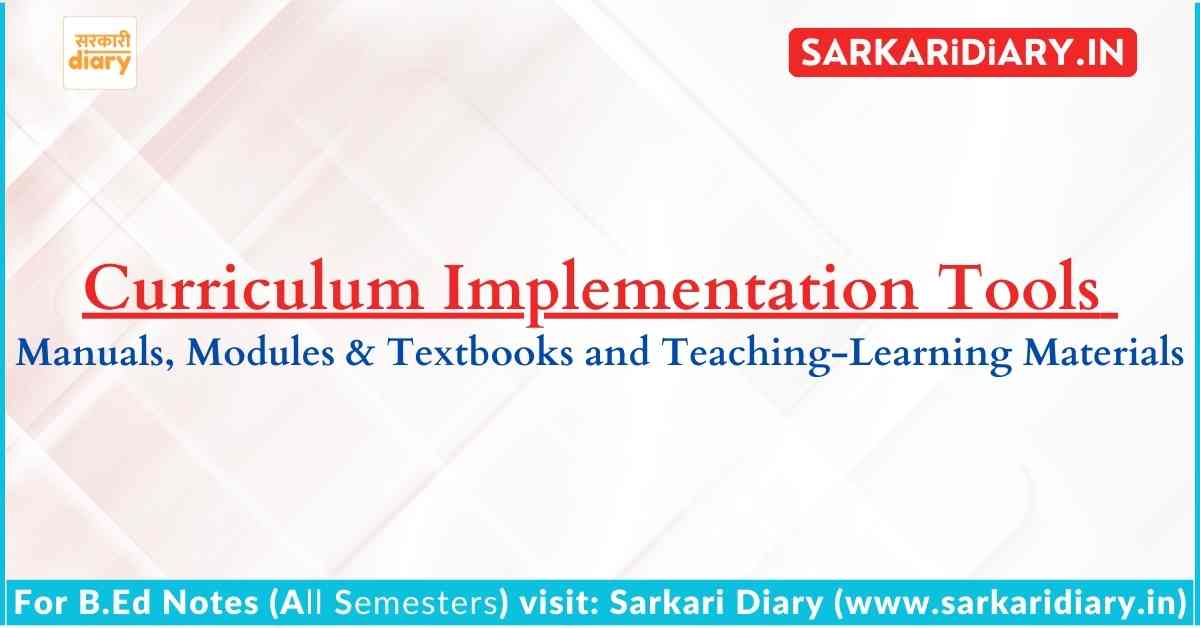Curriculum implementation is a critical phase in the educational process that translates theoretical frameworks into practical, classroom-based activities. To support this transition effectively, educators and policymakers rely on a set of structured tools. These tools not only guide instruction but also ensure that educational objectives are met efficiently and consistently.

This article explores three primary tools used in curriculum implementation: Manuals, Textbooks and Teaching-Learning Materials, and Modules—each serving a distinct function in enhancing learning outcomes and supporting educational reform.
Manuals: Frameworks for Curriculum Change and Implementation
Manuals are comprehensive documents that outline the philosophical, structural, and procedural aspects of curriculum development and change. They provide both conceptual and practical guidance to curriculum professionals, educators, and administrators.
Key Features of Manuals
| Conceptual Framework | Focuses on understanding curriculum change as an ongoing, dynamic process. |
| Quality and Relevance | Emphasises the importance of quality education and relevance to learner needs. |
| Stakeholder Involvement | Highlights the role of various stakeholders in curriculum development. |
| Policy and System Implications | Covers impacts on policy-making, resource allocation, and governance. |
| Practical Application | Useful for training educators, addressing learning gaps, and community outreach. |
Impacted Areas
| Policy formulation Curriculum framework design Textbook development Teacher training Assessment strategies Resource and system management |
Textbooks and Teaching-Learning Materials
Textbooks and teaching-learning materials are the tangible elements of curriculum delivery. They bridge the gap between theoretical content and the classroom, offering structured content aligned with national or state-level curriculum frameworks.
Key Considerations in Textbook Development
| Policy and Trends | Reflect current policies and pedagogical trends in education. |
| Stakeholder Roles | Involves ministries, curriculum developers, teachers, and publishers. |
| Models and Frameworks | Offers multiple models to fit diverse educational contexts. |
| Material Selection and Production | Based on curriculum needs, relevance, learner age, and learning objectives. |
Types of Teaching-Learning Materials
- Textbooks
- Workbooks
- Visual aids (charts, diagrams, posters)
- Digital content (videos, simulations)
- Supplementary readers and practice sheets
These resources support interactive and multi-sensory learning, catering to diverse learning styles.
Modules: Self-Contained Learning Units for Capacity Building
Modules are standalone instructional units that offer targeted learning experiences. They are especially useful for training educators, conducting capacity-building workshops, and implementing curriculum reforms at various levels.
Components of a Module
| Objectives | Clearly defined learning outcomes for teachers or learners. |
| Content | Thematic and structured material based on curriculum standards. |
| Teaching Strategies | Suggested pedagogical approaches and methodologies. |
| Assessment Tools | Embedded formative or summative evaluation instruments. |
Focus Areas in Capacity-Building Modules
| Curriculum philosophy and change Innovations in teaching and learning Integration of ICT in pedagogy Teacher education and school-based training Whole-school development strategies |
Organisational Structure of Modules
| Approaches to Capacity Building | Identifies training needs and strategies for ongoing professional development. |
| Curriculum Specialist Training | Analyses technical skills required for curriculum reform. |
| Teacher Involvement | Highlights the importance of teachers as active agents in the capacity-building process. |
Modules serve as customisable tools that can be tailored to suit regional, institutional, or subject-specific needs.
Conclusion
Effective curriculum implementation relies on a blend of theory, structured content, and continuous capacity building. Manuals, Textbooks, and Modules are three essential tools that support educators and curriculum developers in translating policy into classroom practice.
By integrating these tools effectively, schools and educational systems can ensure:
- Higher teaching efficacy
- Improved student learning outcomes
- Stronger alignment between goals and instructional delivery
As the Indian education system undergoes continuous reform under frameworks like NEP 2020, investing in the design and utilisation of these tools becomes more important than ever.